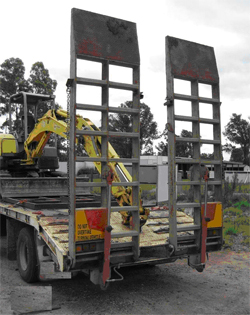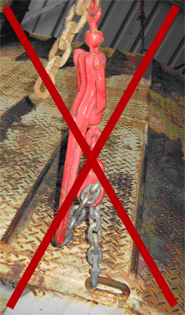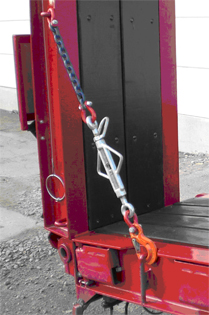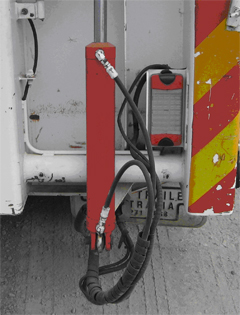Truck and trailer ramps
Issued: 18 April 2013
Last Updated: 18 April 2013
Purpose
The purpose of this safety alert is to highlight the risks associated with powered ramps on trucks and trailers.
Background
A worker was severely injured while helping lower a ramp on a trailer used to transport heavy mobile plant. The raised ramp had been secured back to the trailer deck with a chain and chain tensioning device (over-centre 'dog'). To help another worker release the dog, he stood behind the left side ramp and pushed it towards the front of the trailer. When the dog was released, the ramp dropped back towards him rapidly and struck him, causing significant injuries.
Photograph 1 shows the ramps involved in the incident and photograph 2 shows a chain tensioning dog.
Photograph 1: Trailer ramps with single acting hydraulic cylinders |
Photograph 2: Chain tensioning dog used in the incident to hold (lock) the ramp in the up position – this is not safe (see contributing factors). |
Contributing factors
The worker was pushing against the ramp to reduce tension in the chain and assist in the removal of the over-centre dog (chain tensioning device).
These devices can release violently and cause injury to the operator, particularly if the chain has been over tensioned. In this case, the worker was struck by the falling ramp before he could move out of the way. The sudden release of the tensioned dog caused the ramp to spring back quickly then drop at a much faster rate than expected. If the chain had been tensioned with a device that could have been released from the side of the trailer, the worker would not have been in the way of the dropping ramp.
Photograph 3: Turnbuckle tensioning device with lock nut |
Photograph 4: Double acting hydraulic cylinder (note: two hydraulic lines) |
Action required
Operational issues
- Workers should never stand where they could be struck by a falling ramp.
- Ramps should not be secured for travel with over-centre dogs (see photograph 2). Load tensioning devices that have either ratchet or turnbuckle tensioning systems are better (see photograph 3). Fixed length and specifically designed tie bars can also be used.
- Clearly visible signs at the rear of the vehicle warning people to remain clear of ramps at all times help to highlight the risk.
- If the lowering speed of the ramps is adjustable, the device used to vary the speed (e.g. a flow control valve) should be locked with a key or tool to minimise the likelihood of unauthorised use.
- Only load rated chains, tensioners, connectors and anchors should be used to secure the ramps.
Design issues
- Ramps powered by double acting hydraulic cylinders (see photograph 4) are preferable to those powered by single acting cylinders. These ramps can be fully raised and lowered without the need for workers to touch the ramps. Single acting cylinder ramps require the operator to initially push the ramp to start it lowering. This increases the risk of workers getting in the path of the ramps. These ramps also introduce exposure to hazardous manual tasks. The likelihood of injury from single acting cylinder ramps can increase because an operator working alone will need to push the ramp with one hand while the other is operating the ramp control switch.
- The ramp control switch should be of a type requiring constant pressure (also known as 'deadman'), that requires the operator to stay next to the control panel during raising and lowering of the ramp, reducing the risk of the operator being in the path of the ramps.
- The ramp control switch should be located on the left side of the trailer or vehicle where the operator is out of the path of the ramps and other vehicles.
Additional advice about the correct operation of powered ramps can be found in the manufacturer's instructions.
Further information
- How to manage work health and safety risks Code of Practice 2021 (PDF, 0.65 MB)
- Hydraulics safety (PDF, 0.85 MB)
- Managing the risks of plant in the workplace Code of Practice 2021 (PDF, 1.57 MB)



